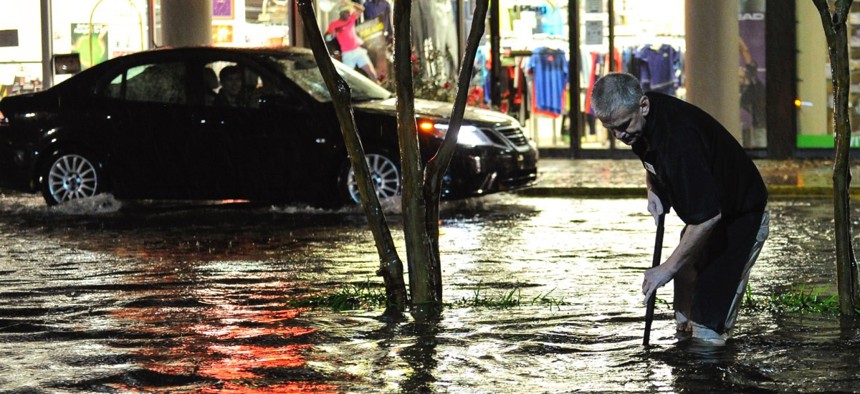Atlanta Gets Creative Financing Green Infrastructure

A store manager works to free a clogged storm sewer drain in a shopping center parking lot after a line of heavy rain moved through the area caused flooding in November 2015 in Atlanta. Jon Amis / AP Photo

Connecting state and local government leaders
The city plans to undertake eight projects worth $12.9 million making its Westside more resilient to flooding.
Atlanta is the first U.S. city to use a publicly offered environmental impact bond to fund green infrastructure projects, which the Department of Watershed Management plans to use to improve drainage in a neighborhood plagued by flooding.
The city proposed eight projects worth $12.9 million for improving the resilience of the Proctor Creek Watershed and nearby, flood-prone Westside neighborhoods to win The Rockefeller Foundation’s Environmental Impact Bond Challenge.
Investment advisory firm Quantified Ventures is helping Atlanta structure the deal, while financial technology company Neighborly is acting as underwriter.
“I think it really allows the municipality to deploy green infrastructure and apply the findings of projects to its broader infrastructure plans,” Lindsey Brannon, Neighborly's head of public finance, told Route Fifty.
The municipal bond market is worth a billion dollars per day, Brannon said, but issuers and investors increasingly seek a “pay-for-success” model that measures project impact—holding state and local governments more accountable for their spending.
Neighborly first worked with DC Water in 2016 on a private environmental impact bond, or EIB, for green infrastructure projects aimed at flood relief. Payment was dictated by successful stormwater reduction over several years.
Rockefeller helped finance that offering and later partnered with Neighborly in July on the new, public challenge. The foundation provides grant funding on Neighborly’s online brokerage platform, which then underwrites the bonds and places investors.
There’s enough funding for two cities, but Atlanta was the first to be announced.
Green infrastructure captures water with soil and vegetation more cheaply than traditional grey infrastructure, while also creating more urban green space. All eight of the city’s proposed projects—including bioretention basins, stormwater planters, bump-outs, and permeable pavement—are designed to reduce strain on its combined wastewater-stormwater sewer system.
“Utilities nationwide are all searching for innovative ways to acquire creative financing, and these projects will successfully demonstrate how community partners working together can advance green infrastructure for our communities,” said Kishia Powell, Watershed Management commissioner, in the March announcement.
Atlanta has spent $2 billion on wastewater infrastructure in recent years, earning a Clean 13 designation in 2017 from the Georgia Water Coalition.
Projects benefiting Vine City, English Avenue, Mozley Park, Grove Park, and the Bankhead/Hollowell corridor were shovel-ready, Brannon said, and having stakeholder buy-in ahead of time made Atlanta the perfect choice for an EIB. Neighborly needed an upfront revenue source that could pay back the bonds and wanted to see them benefit vulnerable communities while growing the investor base interested in resilience, Brannon said.
“We wanted to make sure the contribution of the project was also scalable,” Brannon said. “Other cities could use this as an example of impact, in terms of financing approach.”
Dave Nyczepir is a News Editor at Government Executive’s Route Fifty and is based in Washington, D.C.

NEXT STORY: IRS, Treasury Take Icy View of State Workarounds to Capped Deduction





